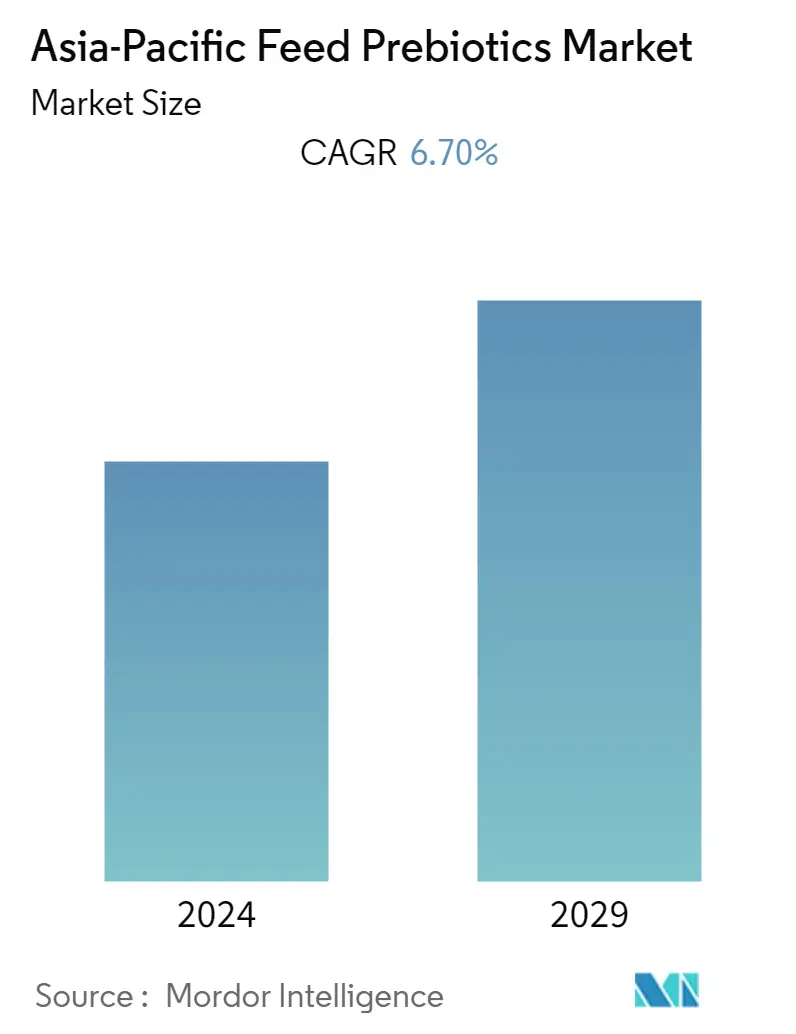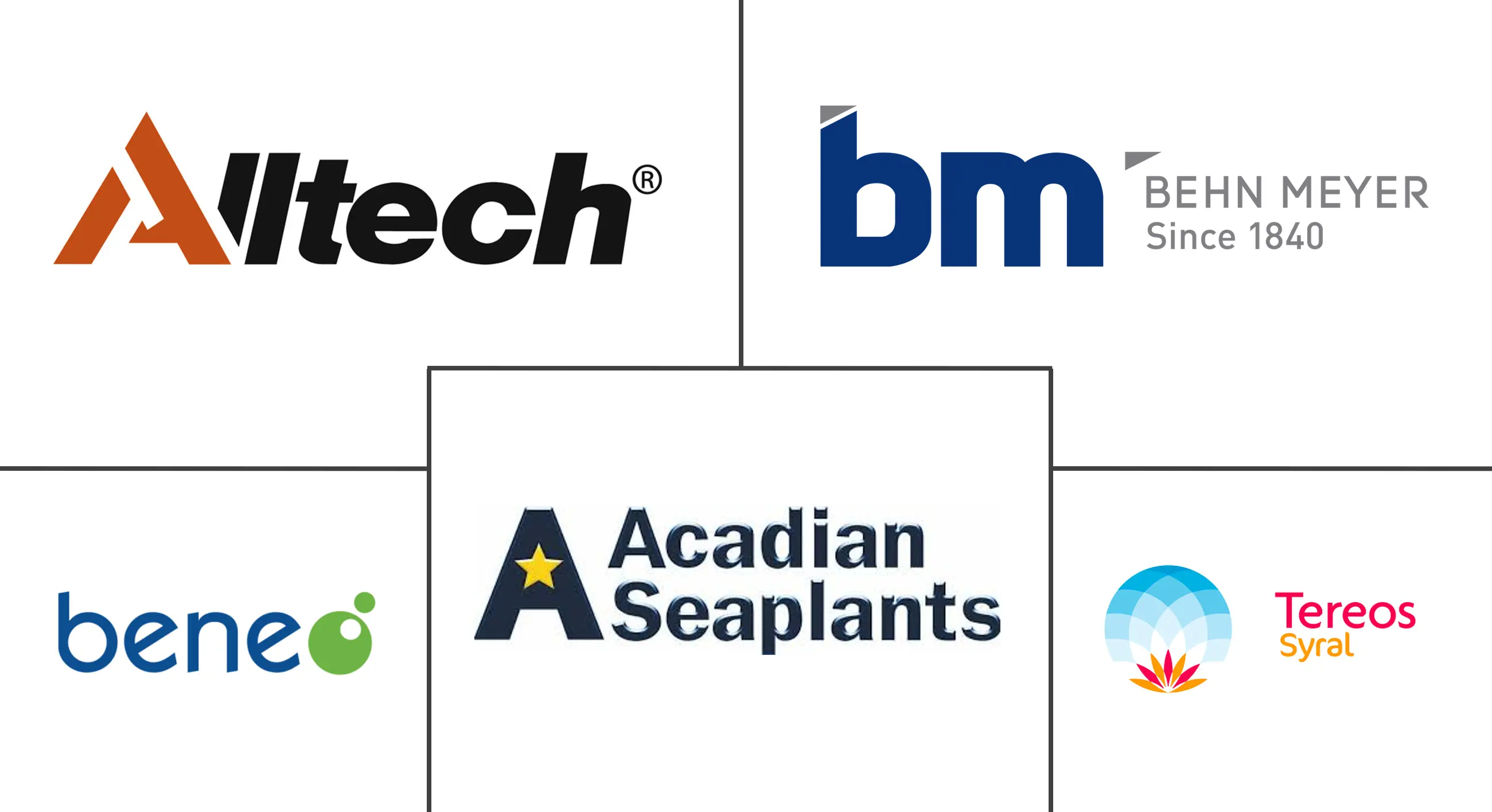Market Size of Asia-Pacific Feed Prebiotics Industry

| Study Period | 2019 - 2029 |
| Base Year For Estimation | 2023 |
| Forecast Data Period | 2024 - 2029 |
| Historical Data Period | 2019 - 2022 |
| CAGR | 6.70 % |
| Market Concentration | Low |
Major Players
*Disclaimer: Major Players sorted in no particular order |
APAC Feed Prebiotics Market Analysis
The Asia Pacific feed prebiotics market is projected to register a CAGR of 6.7% over the forecast period (2020-2025). Growth in the industrial production of livestock and processed meat industry is driving the demand for feed prebiotics in the region. Increasing consumer awareness and the occurrence of livestock diseases have led the way to feed prebiotics market growth. The consumers are giving importance to the extrinsic qualities and attributes of the meat that they consume, and the conditions under which the meat is produced. Certain pathogenic and parasitic contamination in meat products, such as Salmonella, Listeria, and E. coli, along with outbreaks of various diseases among the livestock animals, such as Avian Influenza and African Swine Fever, have raised concerns about the quality and safety of meat. This has led to the use of feed additives, such as enzymes, prebiotics, and vitamins, which provide balanced nutrition to the animals and protect them against such harmful environmental factors. Thus, increased awareness and high demand for safe meat and milk products are prompting the livestock industry and meat manufacturers to use additives, like prebiotics.
APAC Feed Prebiotics Industry Segmentation
The report covers the prebiotics used in compound feed, as a part of the market scope. The market for prebiotics used as supplements in home-based feed is excluded from the market scope and the end consumers of the products include feed mills. On the basis of type, the global feed prebiotics market is segmented into inulin, fructooligosaccharides, galactooligosaccharides, and other types. On the basis of animal type, the market is segmented into ruminants, poultry, swine, aquaculture, and other animal types. Furthermore, on the basis of geography, the market is segmented into major countries of the Asia Pacific region.
| Type | |
| Inulin | |
| Fructo-Oligosaccharides | |
| Galacto-Oligosaccharides | |
| Other Types |
| Animal Type | |
| Ruminants | |
| Poultry | |
| Swine | |
| Aquaculture | |
| Other Animal Types |
| Geography | |
| China | |
| India | |
| Japan | |
| Australia | |
| Thailand | |
| Rest of Asia-Pacific |
Asia-Pacific Feed Prebiotics Market Size Summary
The Asia-Pacific feed prebiotics market is experiencing significant growth, driven by the increasing industrial production of livestock and the processed meat industry. This growth is further fueled by heightened consumer awareness and concerns over livestock diseases, which have underscored the importance of feed prebiotics. Consumers are increasingly prioritizing the quality and safety of meat products, prompting the livestock industry to adopt feed additives like prebiotics to ensure balanced nutrition and protect against environmental threats. The region's status as a leading compound feed producer and consumer amplifies the impact on the feed prebiotics market, with demographic shifts and rising income levels altering dietary preferences and boosting per capita meat and seafood consumption.
The market is characterized by a fragmented landscape, with global and regional players competing vigorously alongside local entities. Key players such as Alltech, Inc., Cargill, Inc., and Beneo GmbH are focusing on quality through substantial investments in product research and development, aiming to expand their product lines and innovate new offerings. The inulin segment, in particular, has shown robust growth due to its beneficial effects on aquaculture and its extensive use in animal feed, despite competition from human consumption markets. This sustained demand for inulin highlights its critical role in enhancing animal nutrition within the Asia-Pacific feed prebiotics market.
Asia-Pacific Feed Prebiotics Market Size - Table of Contents
-
1. MARKET DYNAMICS
-
1.1 Market Overview
-
1.2 Market Drivers
-
1.3 Market Restraints
-
1.4 Porter's Five Forces Analysis
-
1.4.1 Bargaining Power of Suppliers
-
1.4.2 Bargaining Power of Buyers
-
1.4.3 Threat of New Entrants
-
1.4.4 Threat of Substitute Products
-
1.4.5 Intensity of Competitive Rivalry
-
-
-
2. MARKET SEGMENTATION
-
2.1 Type
-
2.1.1 Inulin
-
2.1.2 Fructo-Oligosaccharides
-
2.1.3 Galacto-Oligosaccharides
-
2.1.4 Other Types
-
-
2.2 Animal Type
-
2.2.1 Ruminants
-
2.2.2 Poultry
-
2.2.3 Swine
-
2.2.4 Aquaculture
-
2.2.5 Other Animal Types
-
-
2.3 Geography
-
2.3.1 China
-
2.3.2 India
-
2.3.3 Japan
-
2.3.4 Australia
-
2.3.5 Thailand
-
2.3.6 Rest of Asia-Pacific
-
-
Asia-Pacific Feed Prebiotics Market Size FAQs
What is the current Asia-Pacific Feed Prebiotics Market size?
The Asia-Pacific Feed Prebiotics Market is projected to register a CAGR of 6.70% during the forecast period (2024-2029)
Who are the key players in Asia-Pacific Feed Prebiotics Market?
Alltech Inc., Beneo GmbH, Acadian Seaplants Ltd , Behn Meyer and Beghin Meiji (Tereos S.A.) are the major companies operating in the Asia-Pacific Feed Prebiotics Market.

